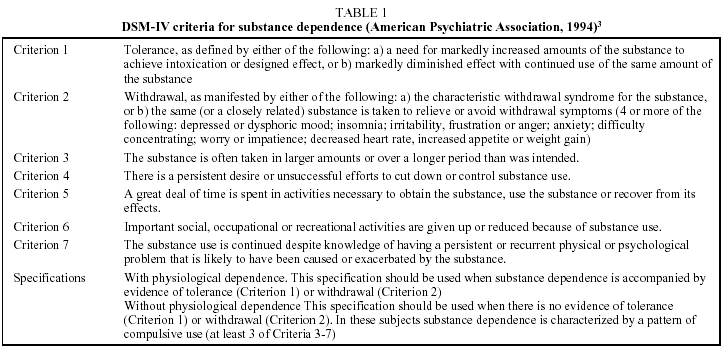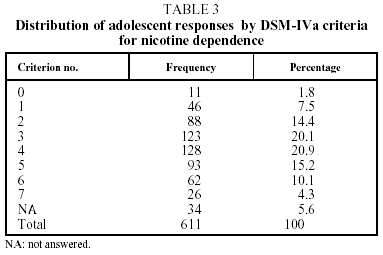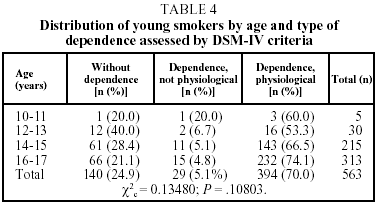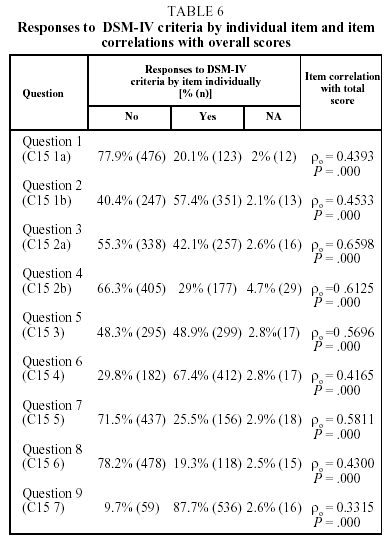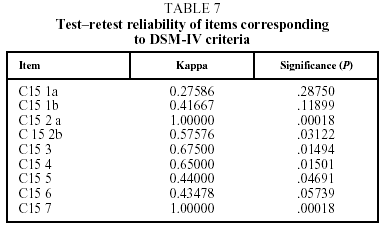Introduction
The concept of chemical dependence has changed over the years. At first it was understood as dependence on a drug that was able to cause characteristic symptoms of withdrawal when the substance was no longer being administered and that harmed not only the individual but also society; heroin was considered the prototypical substance1. Other substances, on the other hand, were considered to cause psychological, but not physical, dependence that did not endanger society; cocaine and nicotine were to be found in this group. However, more recent studies have shown that these latter substances are also capable of creating physical dependence, harming both the user and society. Thus the terms chemical dependence and drug-addiction are considered to be scientifically equivalent1.
The Diagnostic and Statistical Manual of Mental Disorders in its fourth edition (DSM-IV) is used almost everywhere in the world as an official psychiatric nomenclature. The DSM-IV is consistent with the ninth revision of the International Classification of Diseases (ICD-9), published by the World Health Organization (WHO), and with the ICD-9 Clinical Modification published by the Department of Health and Human Services (U.S.A.)2.
The DSM-IV identifies smoking as "a disorder caused by a substance capable of causing dependence" and classifies it with disorders related to psychoactive substances: nicotine dependence, code 305.103. Thus, nicotine dependence is defined in the DSM-IV as the presence of three or more of the symptoms listed in Table 1 appearing at any moment during the same 12-month period3.
Given the lack of studies that quantify nicotine dependence in young smokers under the DSM-IV criteria, we decided to evaluate the usefulness of a version with language adapted to be more comprehensible to adolescents (DSM-IVa) in the diagnosis of nicotine dependence. We also aimed to assess nicotine dependence in young smokers using this criteria and to specify the most important items with which to evaluate this dependence in students.
Material and methods
The population consisted of students from public and subsidized schools in Zaragoza (Spain), aged between 10 and 17 years old at the beginning of the 1997-1998 school year. A total of 52,978 students were on the lists provided by the schools in question.
A sample size was calculated for each year of age (10 through 17 years), using the finite population equation (for an absolute error of e=0.06 and a reliability coefficient of 95%), adding 10% so that the absolute error would not increase at the end of the study if some questionnaires were invalid. The sample was stratified by sex and type of school (public, subsidized) for each age group, with allocation to each stratum proportional to the number of individuals. The individuals of 15 years old and above were also stratified by type of studies (secondary; vocational training, etc.). To avoid possible bias one school from among every five schools was chosen at random. Pupils from each school were chosen using random number tables based on class lists and age.
The selected students were given an anonymous questionnaire, to be self-administered, created for this specific study and previously validated. As the questionnaire was self-administered, it was validated using a test-retest procedure with a 15-day interval, calculating the agreed percentage and weighted kappa values item by item. We adapted for adolescents the language of questions that seemed confusing to students in a pilot study or that gave rise to errors in filling in the questionnaire.
In order for the students not to feel pressured in their choice of answers, we asked that no teachers be present while the questionnaires were answered. On the day of the study, data collection took place immediately after a school break, when students smoke most.
The questionnaires were given out by trained medical staff who made clear to the students that the answers they might give to this anonymous questionnaire would not be known by either their teachers or their parents.
A total of 2,647 school-aged subjects responded, and the 611 who said that they were smokers were selected for the study; 10.5% of the questionnaires had to be discarded because they were incomplete or because two options were chosen for the same question.
The students were classified according to WHO categories4 as follows: young daily smoker (one who smokes any tobacco product daily at the time of filling in the questionnaire); young weekly smoker (one who smokes at least once a week, but not every day, at the time of filling in the questionnaire; young uncommitted smoker (occasional or sporadic smoker, i.e., one who smokes less than once a week), and young nonsmoker (does not smoke at the time of the study).
The DSM-IV criteria (Table 1) were adapted to contain language that could be easily understood by the students, and they were asked to answer "yes" or "no" to the statements in Table 2 from the validated questionnaire.
In the pilot study that had been carried out earlier, the overall prevalence of smoking was found to be 37.9%. After that study, we modified the questionnaire and the manner and timing of its administration to correct detected faults. The questionnaire was then validated using a testretest procedure, with a 15 day interval. The choice of this interval of time was based on the conclusions of Becoña et al5, who observed that self-observation of smoking behavior through self-questionnaires is accompanied by a decrease in cigarette use; however, this effect disappears after two weeks.
Statistical analysis
The data was input to an Access computer database. The statistical analysis was carried out using the SPSS/PC statistical package. The questionnaire was validated using the weighted kappa coefficient. The quantitative variables were analyzed using the following estimators: mean, standard deviation, median, interquartile range, kurtosis, skewness, minimum and maximum. The qualitative variables were expressed as absolute and relative frequencies (percentages). Spearman's rho was used to compare variables on an ordinal scale. Pearson chi-square statistic was used to establish the association of dependence between qualitative variables. If more than 20% of the responses had a theoretical frequency less than 5, the continuity correction factor was applied. Kendall's tau was used with 2-by-2 tables to determine the degree of association. When opportune, percentages were contrasted. The internal consistency of the DSM-IVa was evaluated using Cronbach's alpha.
Results
Six-hundred eleven of the 2647 respondents declared themselves to be smokers (23.1%). More females (333/1285; 25.9%) than males (278/1362; 20.4%) smoked. Among the smokers 54.5% (333/611) were female and 45.5% (278/611) were male. From here on, all reported data will refer to adolescent smokers in the sample.
The adolescent student smokers were a mean 15.55 + 1.33 years old. Daily smoking was reported by 63.5% (388/611), and only 35% (214/611) reported not smoking every day.
The distribution of the adolescents in relation to the number of DSM-IVa criteria they met is shown in Table 3. Given that someone is considered nicotine dependent when they fulfill three or more of the given criteria, almost three quarters of the young people (432/611; 70.7%) were nicotine dependent. More than half had had withdrawal symptoms at some time (295/588; 50.2%), and 62.8% (369/588) showed tolerance; more than a third (209/588; 35.5%) showed both. Most (403/611; 66%) showed physiological dependence, and only 4.7% (29/611) were nonphysiologically dependent. There were no statistically significant differences in relation to sex.
We did find differences approaching significance (χ²c=0.11503; P=.05631) in relation to age; 58.4% (247/423) of smokers with dependence were between 16 and 17 years old (Table 4). It should be pointed out that 4 out of 5 children aged 10 to 11 years old who smoked were dependent. More children were found to have both physiological and nonphysiological dependence as age increased, although the differences were not statistically significant.
The DSM-IVa scores for each type of smoker are shown in Table 5. We observed progressive increases in the number of criteria for nicotine dependence as age increased; occasional smokers fulfilled fewer criteria, with an average of 2,425 compared to 4,197 for daily smokers. Dependence was related to smoker type, as the number who were daily smokers and nicotine dependent (56.3%; 321/570) was greater than the number who were not (8.8%; 50/570) (χ²=79.76958; P=.00). Similarly, most of the daily smokers (86.5%; 303/371) developed physiological dependence, whereas only 36.78% (32/87) of the occasional smokers did so, the difference being statistically significant (P<.05).
In the analysis of dependence according to the DSM-IVa score in relation to the number of cigarettes smoked per day, it was observed that all of those who smoked more than 20 cigarettes a day (18/18) and almost 90% of those who smoked between 11 and 20 per day (89.9%; 71/79) were highly dependent, the difference being statistically significant (χ²=17.87888; P=.00013).
The results for each item on the DSM-IVa are shown in Table 6. The item that received an affirmative answer most frequently was question 9 (C15 7), to which almost 90% (87.7% of the smokers) agreed that they smoke in spite of knowing that cigarettes damage their health; the next item most frequently answered affirmatively was criterion C15 4 (question 6), to which 67.4% reported that they wished to stop smoking or had tried to stop at some point. The items that correlated best with the total DSM-IVa score and that therefore most affected the final score, were C15 2a and C15 2b, (Δo=0.6598 and Δo=0.6125, respectively); these items are those related to the presence of withdrawal syndrome. However, it should be pointed out that the correlation, in general, was low but quite uniform, with rho values between 0.3315 and 0.6598.
The internal consistency of the DSM-IVa was good according to Cronbach's alpha (α=0.5598). However, the correlation amongst the criteria according to the Kendall tau coefficient was low, which suggests that all of the questions are important for the diagnosis of dependence. The strongest correlations were between criteria C15 A (C15 2a and C15 2b) and C15 5 (Φ=0.3408), referring to the presence of withdrawal syndrome symptoms and the time spent smoking or obtaining cigarettes, respectively. As can be observed in Table 7, the test-retest reliability of the items was moderate, varying greatly from one item to another; items C15 2a and C15 7 were those for which agreement was best (100%).
Discussion
The smoking habits of adolescents have been well described based on self-administered questionnaires and both the validity and reliability of the approach has been demonstrated by numerous studies6-11. The main advantage of the method is that a large amount of information about a large number of people can be obtained easily12,13.
The fact that the questionnaires were anonymous and that the teachers were absent at the time of response contributed to sincerity in answering, reducing the possible systematic error that the lack of truthfulness could cause, a situation that has been described elsewhere14.
Almost three quarters of the adolescents (70.7%) were nicotine dependent according to the DSM-IVa (16.1% of all students who answered the questionnaire, smokers and nonsmokers), and only 23.7% of the smokers were not. These figures are somewhat lower than those obtained by Nelson and Wittchen15, who detected that 19% of adolescents between 14 and 24 years old were nicotine dependent as defined by the DSM-IV; they are also lower than the figures of Stanton16, who found that more than 80% of 18 year-old smokers were nicotine dependent as defined by the DSM-III-R17. We consider that these differences are due to the different age ranges surveyed, since in the cited studies children between 10 and 13 years old were not included as they were in ours.
The components of the subjects' dependency are multiple. However, there are two in particular that should be pointed out: tolerance and withdrawal symptoms18,19. On the one hand, tolerance of the unpleasant effects that cigarette smoking causes will gradually lead to their disappearance, such that the experience a young person does not enjoy at the beginning loses its negative character20,21. On the other hand, the attributes that the adolescent has been investing in cigarettes encourage him/her to seek beyond the clumsiness of the first experience; little by little they smoke more often, learning to recognize and experience the physical reinforcement that the arrival of nicotine to the brain provides, the social reinforcement of having a skill that characterizes the group and the psychological reinforcement of assimilating a skill which acts as the prop of an immature and inconsistent identity20. Thus, when in this process the cigarette becomes a necessary element in a person's life, the substance has already caused a psychological dependence22,23. The smoker's organism becomes accustomed to a certain nicotine level until, finally, he or she needs that dose to "function" in social and work environments and to avoid withdrawal syndrome20,24. This is reflected in our sample, where, of those questioned at such a young age, more than half (50.2%) had already had withdrawal symptoms at some point and 62.8% had reached tolerance; more than a third (35.5%) reported both tolerance and withdrawal symptoms.
Once a smoker has been defined as dependent, it should be specified whether dependence is physiological (with signs of tolerance and/or withdrawal symptoms) or nonphysiological (with no signs either of tolerance or withdrawal)3. We saw how most (66%) displayed physiological dependence, and only 4.7% were non-physiologically dependent. It is striking that 455 students reported tolerance and/or had withdrawal symptoms and only 403 were physiologically dependent. This is because there were 52 smokers (8.51%) who, in spite of tolerance and/or having withdrawal symptoms, failed to fulfill the DSM-IV criteria for dependence because, as explained, tolerance and withdrawal symptoms are only two of the criteria defining nicotine dependence and they may even be absent.
Consistent with reports of other authors15, we did not find significant differences by age, although we did observe more adolescents with dependency as age increased. Moreover, it should be pointed out that 4 out of 5 children aged 10 to 11 years old who smoked were nicotine dependent, leading to the suspicion that those who already smoke at such a young age develop dependency very quickly. Similarly, on analyzing dependence by smoker type, it was observed that, as occasional smokers become daily users, the number of criteria for dependence that they fulfilled increased, and differences were found according to smoker type; thus, it was observed that most daily smokers (81.7%) developed physiological dependence. However, it should be pointed out that 36.8% of the occasional smokers were also physiologically dependent. These findings are consistent with the usual evolution of smoking, where one begins by smoking little at very specific moments (occasional smoker), usually associating cigarettes with pleasurable situations (meetings with friends, pubs, discotheques, etc.)25. This association will make the smoker want to relive those sensations more and more in a greater number of situations, passing from occasional to weekly smoking. The more an individual smokes, the more such associations are established, with concurrent development of greater nicotine tolerance, which means that more must be smoked to obtain the same effects that were once obtained with only one cigarette26. In this way, cigarette use increases and daily smoking becomes established. This will mean, as happened in our sample, physiological and nonphysiological dependence develops as more cigarettes are smoked.
Once nicotine dependence has been established, the individual will smoke in spite of the conviction that it can damage his or her health, and, furthermore, dependence will make him/her continue to smoke in spite of wishing to quit or even of having tried at some point to quit27. It was precisely these two situations that occurred most frequently to our young smokers, who in their main part (87.7%) smoked despite knowing that cigarettes damaged their health; what is more, nearly 70% said that they continued to smoke in spite of desiring to quit or having tried to quit at some point.
When the testretest reliability of the DSM-IVa was calculated based on overall scores, a kappa value of 1 was obtained. We investigated to see if this was maintained for each item, finding that reliability was moderate-good, with great variation from one item to another (from a maximum agreement and a kappa value of 1 in the question that refers to the fact of continuing to smoke in spite of knowing that smoking damages health and the question referring to having experienced withdrawal syndrome). However, item C15 1a, referring to the need to smoke more and more cigarettes over time, obtained a low kappa value, which we consider may be due to the young smokers interpreting that they had smoked more cigarettes between their two responses to the questionnaire (15 days). The fact that the correlation among all the criteria was low and the agreement in the test-retest procedure for some questions moderate, in spite of the fact that agreement in the total score was high, indicates that those surveyed answered some questions at random, perhaps because they did not understand them, or perhaps because the criteria for dependence were not clearly defined for adolescents. However, internal consistency of the DSM-IVa questions according to the Cronbach test was good, with an α value of 0.5598, supporting the unidimensionality of the scale28. The fact that the criteria which correlated best both with the overall DSM-IVa score and with each other were those referring to the presence of withdrawal syndrome, and the need to spend a large part of free time obtaining or smoking cigarettes, indicates that these are perhaps the two key questions for investigating nicotine dependency in young smokers.
To conclude, the DSM-IVa version of the DSM-IV criteria for nicotine dependence adapted for adolescents is useful in the studied population, although not perfect. According to this version, 70.7% of young smokers between 10 and 17 years old have already become nicotine dependent, the key questions being those referring to the presence of withdrawal syndrome and the need to spend a large part of free time obtaining and smoking cigarettes. Consequently we consider that research should continue to look for a system for assessing nicotine dependence in this population, whose smoking is so unique both quantitatively and qualitatively.
This work was partly supported by SEPAR-98 and SADAR-98 grants.
Correspondence: Dr. M.L. Clemente Jiménez.
CS Perpetuo Socorro. Ramón y Cajal, 57. 22006 Huesca. Spain
E-mail: lclementej@papps.org
Manuscript received 5 July 2002.
Accepted for publication 23 October 2002.


